Manipulation of Microstructure and Mechanical Properties in N-Doped CoCrFeMnNi High-Entropy Alloys
Abstract
:1. Introduction
2. Experimental
3. Results and Discussion
4. Conclusions
- 1.
- N doping in the CoCrFeMnNi HEA results in a unique complex heterogeneous microstructure via inhibiting the recrystallization process, allowing grain refinement, and precipitating nanoscale Cr2N particles, simultaneously.
- 2.
- The yield strength and ultimate tensile strength of as-annealed N0.3 HEA are 690 and 940 MPa, respectively, which exceeds more than twice those of as-annealed N0 HEA. Although the elongation of as-annealed N0.3 HEA (~10%) is much lower than that of as-annealed N0 HEA (~40%), it still has a meaningful value that can be used commercially.
- 3.
- The exceptional strengthening in as-annealed N0.3 HEA can be achieved by the simultaneous operation of four different strengthening mechanisms from the unique complex heterogeneous microstructure. The contribution of different strengthening mechanisms to the overall yield strength increment in N0.3 HEA is~129.3 MPa of ΔσP ≥ ~124.8 MPa of ΔσD > ~89.3 MPa of ΔσS > ~26.6 MPa of ΔσG, which means that yield-strength increment in as-annealed N0.3 HEA is attributed to the combination effect of the precipitation of Cr2N, dislocation strengthening (via 77% non-recrystallized zone with higher dislocation density), and the solid solution of nitrogen (via a large amount of solution-soluted N content, 0.3 wt.%).
Author Contributions
Funding
Data Availability Statement
Conflicts of Interest
References
- Zhang, Y.; Zuo, T.T.; Tang, Z.; Gao, M.C.; Dahmen, K.A.; Liaw, P.K.; Lu, Z.P. Microstructures and properties of HEAs. Prog. Mater. Sci. 2014, 61, 1–93. [Google Scholar] [CrossRef]
- Tsai, M.H.; Yeh, J.W. HEAs: A critical review. Mater. Res. Lett. 2014, 2, 107–123. [Google Scholar] [CrossRef]
- Miracle, D.B.; Senkov, O.N. A critical review of high entropy alloys and related concepts. Acta Mater. 2017, 122, 448–511. [Google Scholar] [CrossRef] [Green Version]
- Choi, Y.T.; Bae, J.W.; Park, J.M.; Lee, H.H.; Kwon, H.S.; Son, S.J.; Ahn, D.H.; Kim, H.S. Stretch-flangeability of CoCrFeMnNi HEA. Mater. Sci. Eng. A 2021, 841, 141241. [Google Scholar] [CrossRef]
- Guo, S.; Chen, H.; Wang, M. Research on the dislocation differences of CoCrFeMnNi with different local chemical orders during room temperature tensile test. J. Alloys Compd. 2021, 868, 159215. [Google Scholar] [CrossRef]
- Otto, F.; Dlouhý, A.; Somsen, C.; Eggeler, H.B.; George, E.P. The influences of temperature and microstructure on the tensile properties of a CoCrFeMnNi HEA. Acta Mater. 2013, 61, 5743–5755. [Google Scholar] [CrossRef] [Green Version]
- Gludovatz, B.; Hohenwarter, A.; Catoor, D.; Chang, E.H.; George, E.P.; Ritchie, R.O. A fracture-resistant HEA for cryogenic applications. Science 2014, 345, 1153–1158. [Google Scholar] [CrossRef] [PubMed] [Green Version]
- Naeem, M.; He, H.Y.; Zhang, F.; Naeem, M.; He, H.Y.; Zhang, F.; Huang, H.L.; Harjo, S.; Kawasaki, T.; Wang, B.; et al. Cooperative deformation in HEAs at ultralow temperatures. Sci. Adv. 2020, 6, eaax4002. [Google Scholar] [CrossRef] [Green Version]
- Senkov, O.; Isheim, D.; Seidman, D.; Pilchak, A.L. Development of a refractory high entropy superalloy. Entropy 2016, 18, 102. [Google Scholar] [CrossRef]
- Quiambao, K.F.; McDonnell, S.J.; Schreiber, D.K.; Gerard, A.Y.; Freedy, K.M.; Lu, P.; Saal, J.E.; Frankel, G.S.; Scully, J.R. Passivation of a corrosion resistant high entropy alloy in non-oxidizing sulfate solutions. Acta Mater. 2019, 164, 362–376. [Google Scholar] [CrossRef]
- Lei, Z.F.; Liu, X.J.; Wu, Y.; Wang, H.; Jiang, S.H.; Wang, S.D.; Hui, X.D.; Wu, Y.D.; Gault, B.; Kontis, P.; et al. Enhanced strength and ductility in a HEA via ordered oxygen complexes. Nature 2018, 563, 546–550. [Google Scholar] [CrossRef] [PubMed]
- Medina, L.Z.; da Costa, M.V.T.; Paschalidou, E.M.; Lindwall, G.; Riekehr, L.; Korvela, M.; Fritze, S.; Kolozsvári, S.; Gamstedt, E.K.; Nyholm, L.; et al. Enhancing corrosion resistance, hardness, and crack resistance in magnetron sputtered high entropy CoCrFeMnNi coatings by adding carbon. Mater. Des. 2021, 205, 109711. [Google Scholar] [CrossRef]
- Yang, T.; Zhao, Y.L.; Tong, Y.; Jiao, Z.B.; Wei, J.; Cai, J.X.; Han, X.D.; Chen, D.; Hu, A.; Kai, J.J.; et al. Multicomponent intermetallic nanoparticles and superb mechanical behaviors of complex alloys. Science 2018, 362, 933–937. [Google Scholar] [CrossRef] [Green Version]
- Gao, X.Z.; Lu, Y.P.; Zhang, B.; Liang, N.N.; Wu, G.Z.; Sha, G.; Liu, J.Z.; Zhao, Y.H. Microstructural origins of high strength and high ductility in an AlCoCrFeNi2.1 eutectic HEA. Acta Mater. 2017, 141, 59–66. [Google Scholar] [CrossRef]
- Wu, Q.F.; Wang, Z.J.; Hu, X.B.; Zheng, T.; Yang, Z.; He, F.; Li, J.; Wang, J. Uncovering the eutectics design by machine learning in the Al-Co-Cr-Fe-Ni high entropy system. Acta Mater. 2020, 182, 278–286. [Google Scholar] [CrossRef]
- Han, Y.; Li, H.B.; Feng, H.; Tian, Y.Z.; Jiang, Z.H.; He, T. Mechanism of dislocation evolution during plastic deformation of nitrogen-doped CoCrFeMnNi HEA. Mater. Sci. Eng. A 2021, 814, 141235. [Google Scholar] [CrossRef]
- Wang, Z.W.; Baker, I.; Cai, Z.H.; Chen, S.; Poplawsky, J.D.; Guo, W. The effect of interstitial carbon on the mechanical properties and dislocation substructure evolution in Fe40.4Ni11.3Mn34.8Al7.5Cr6 high entropy alloys. Acta Mater. 2016, 120, 228–239. [Google Scholar] [CrossRef] [Green Version]
- Seol, J.B.; Bae, J.W.; Li, Z.M.; Han, J.C.; Kim, J.G.; Raabe, D.; Kim, H.S. Boron doped ultra-strong and ductile HEAs. Acta Mater. 2018, 151, 366–376. [Google Scholar] [CrossRef]
- Xie, Y.C.; Cheng, H.; Tang, Q.H.; Chen, W.; Chen, W.K.; Dai, P.Q. Effects of N addition on microstructure and mechanical properties of CoCrFeNiMn high entropy alloy produced by mechanical alloying and vacuum hot pressing sintering. Intermetallics 2018, 93, 228–234. [Google Scholar] [CrossRef]
- Klimova, M.; Shaysultanov, D.; Semenyuk, A.; Zherebtsov, S.; Salishchev, G.; Stepanov, N. Effect of nitrogen on mechanical properties of CoCrFeMnNi high entropy alloy at room and cryogenic temperatures. J. Alloys Compd. 2020, 849, 156633. [Google Scholar] [CrossRef]
- Jodi, D.E.; Park, J.Y.; Park, N.E. Strengthening of ultrafine-grained equiatomic CoCrFeMnNi HEA by nitrogen addition. Mater. Lett. 2020, 258, 126772. [Google Scholar] [CrossRef]
- Xiong, F.; Fu, R.; Li, Y.; Xu, B.; Qi, X. Influences of nitrogen alloying on microstructural evolution and tensile properties of CoCrFeMnNi HEA treated by cold-rolling and subsequent annealing. Mater. Sci. Eng. A 2020, 787, 139472. [Google Scholar] [CrossRef]
- Sathiyamoorthi, P.; Kim, H.S. High-entropy alloys with heterogeneous microstructure: Processing and mechanical properties. Prog. Mater. Sci. 2020, 100709. [Google Scholar] [CrossRef]
- Ma, E.; Zhu, T. Towards strength–ductility synergy through the design of heterogeneous nanostructures in metals. Mater. Today 2017, 20, 323–331. [Google Scholar] [CrossRef]
- Huang, C.X.; Wang, Y.F.; Ma, X.L.; Yin, S.; Höppel, H.W.; Göken, M.; Wu, X.L.; Gao, H.J.; Zhu, Y.T. Interface affected zone for optimal strength and ductility in heterogeneous laminate. Mater. Today 2018, 21, 713–719. [Google Scholar] [CrossRef] [Green Version]
- Li, Z.M.; Pradeep, K.G.; Deng, Y.; Raabe, D.; Tasan, C.C. Metastable high-entropy dual-phase alloys overcome the strength–ductility trade-off. Nature 2016, 534, 227–230. [Google Scholar] [CrossRef] [PubMed]
- YJo, H.; Jung, S.; Choi, W.M.; Sohn, S.S.; Kim, H.S.; Lee, B.J.; Kim, N.J.; Lee, S. Cryogenic strength improvement by utilizing room-temperature deformation twinning in a partially recrystallized VCrMnFeCoNi HEA. Nat. Commun. 2017, 8, 15719. [Google Scholar]
- Wu, X.L.; Zhu, Y.T. Heterogeneous materials: A new class of materials with unprecedented mechanical properties. Mater. Res. Lett. 2017, 5, 527–532. [Google Scholar] [CrossRef]
- Kim, S.H.; Kim, H.; Kim, N.J. Brittle intermetallic compound makes ultrastrong low-density steel with large ductility. Nature 2015, 518, 77–79. [Google Scholar] [CrossRef]
- Kocks, U.F. A Statistical Theory of Flow Stress and Work-hardening. Philos. Mag. 1965, 123, 541–566. [Google Scholar] [CrossRef]
- Wu, S.W.; Wang, G.; Wang, Q.; Zhang, T.Y. Enhancement of strength-ductility trade-off in a HEA through a heterogeneous structure. Acta Mater. 2019, 165, 444–458. [Google Scholar] [CrossRef]
- Li, Z.M. Interstitial equiatomic CoCrFeMnNi HEAs: Carbon content, microstructure, and compositional homogeneity effects on deformation behavior. Acta Mater. 2019, 164, 400–412. [Google Scholar] [CrossRef]
- Semenyuk, A.; Klimova, M.; Shaysultanov, D.; Salishchev, G.; Zherebtsov, S.; Stepanov, N. Effect of nitrogen on microstructure and mechanical properties of the CoCrFeMnNi high-entropy alloy after cold rolling and subsequent annealing. J. Alloys Compd. 2021, 888, 161452. [Google Scholar] [CrossRef]
- ASTM E112. Standard Test Methods for Determining Average Grain Size; American Society for Testing and Materials: West Conshohocken, PA, USA, 1996. [Google Scholar]
- Gavriljuk, V.G.; Berns, H. High Nitrogen Steels, 1st ed.; Springer: New York, NY, USA, 1999. [Google Scholar]
- Yong, Q.L. Secondary Phases in Steels, 1st ed.; Metallurgical Industry Press: Beijing, China, 2006. [Google Scholar]
- Kikuchi, M.; Kajihara, M.; Choi, S.K. Cellular precipitation involving both substitutional and interstitial solutes: Cellular precipitation of Cr2N in Cr-Ni austenitic steels. Mater. Sci. Eng. A 1991, 146, 131–150. [Google Scholar] [CrossRef]
- Rayaprolu, D.B.; Hendry, A. Cellular precipitation in a nitrogen alloyed stainless steel. Mater. Sci. Technol. 1989, 5, 328–332. [Google Scholar] [CrossRef]
- Ono-Nakazato, H.; Taguchi, K.; Usui, T.; Tamura, K.; Tomatsu, Y. Determination of standard Gibbs energies of formation of Cr2N and CrN. Metall. Mater. Trans. B 2001, 32, 1113–1118. [Google Scholar] [CrossRef]
- Courtney, T.H. Mechanical Behavior of Materials; Long Grove Press: Waveland, MI, USA, 2005. [Google Scholar]
- Traversier, M.; Mestre-Rinn, P.; Peillon, N.; Rigal, E.; Boulnat, X.; Tancret, F.; Dhers, J.; Fraczkiewic, A. Nitrogen-induced hardening in an austenitic CrFeMnNi high-entropy alloy (HEA). Mater. Sci. Eng. A 2021, 804, 14072. [Google Scholar] [CrossRef]
- Ding, Q.Q.; Zhang, Y.; Chen, X.; Fu, X.Q.; Chen, D.K.; Chen, S.J.; Gu, L.; Wei, F.; Bei, H.B.; Gao, Y.F.; et al. Tuning element distribution, structure and properties by composition in high-entropy alloys. Nature 2019, 574, 223–227. [Google Scholar] [CrossRef]
- Zhang, R.P.; Zhao, S.T.; Ding, J.; Chong, Y.; Jia, T.; Ophus, C.; Asta, M.; Ritchie, R.O.; Minor, A.M. Short-range order and its impact on the CrCoNi medium-entropy alloy. Nature 2020, 581, 283–287. [Google Scholar] [CrossRef] [PubMed]
- Moravcik, I.; Hadraba, H.; Li, L.L.; Dlouhy, I.; Raabe, D.; Li, Z.M. Yield strength increase of a CoCrNi medium entropy alloy by interstitial nitrogen doping at maintained ductility. Scr. Mater. 2020, 178, 391–397. [Google Scholar] [CrossRef]
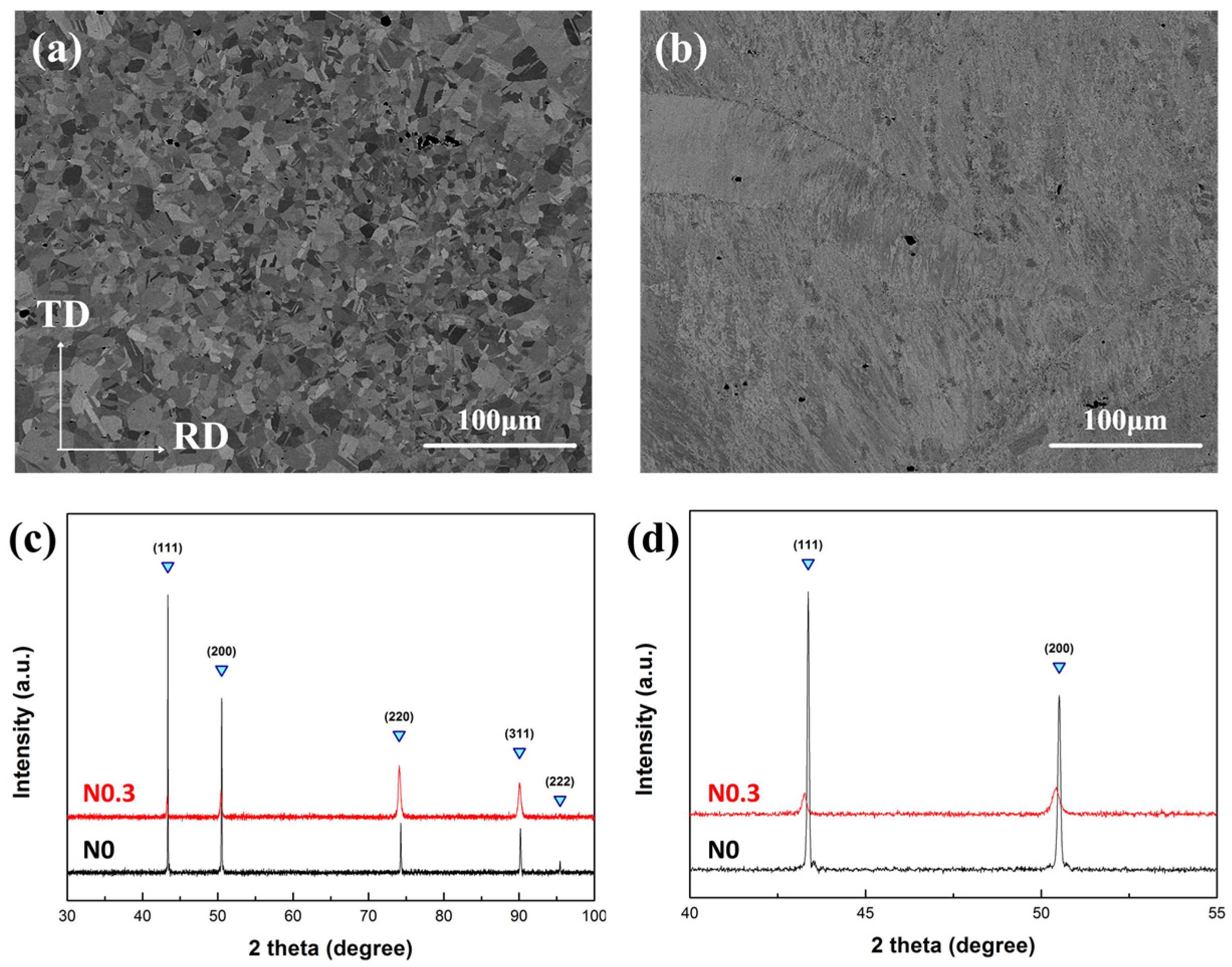
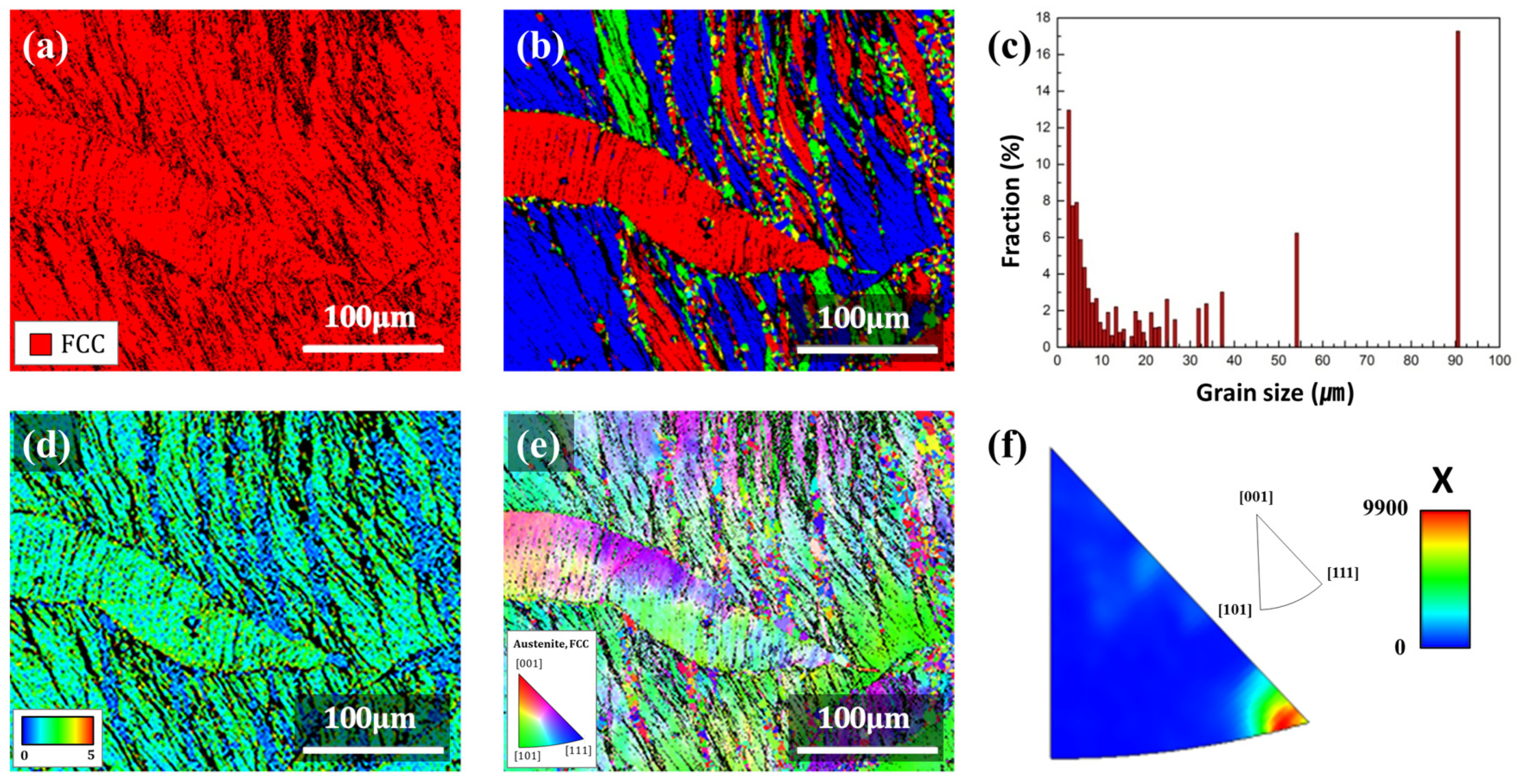
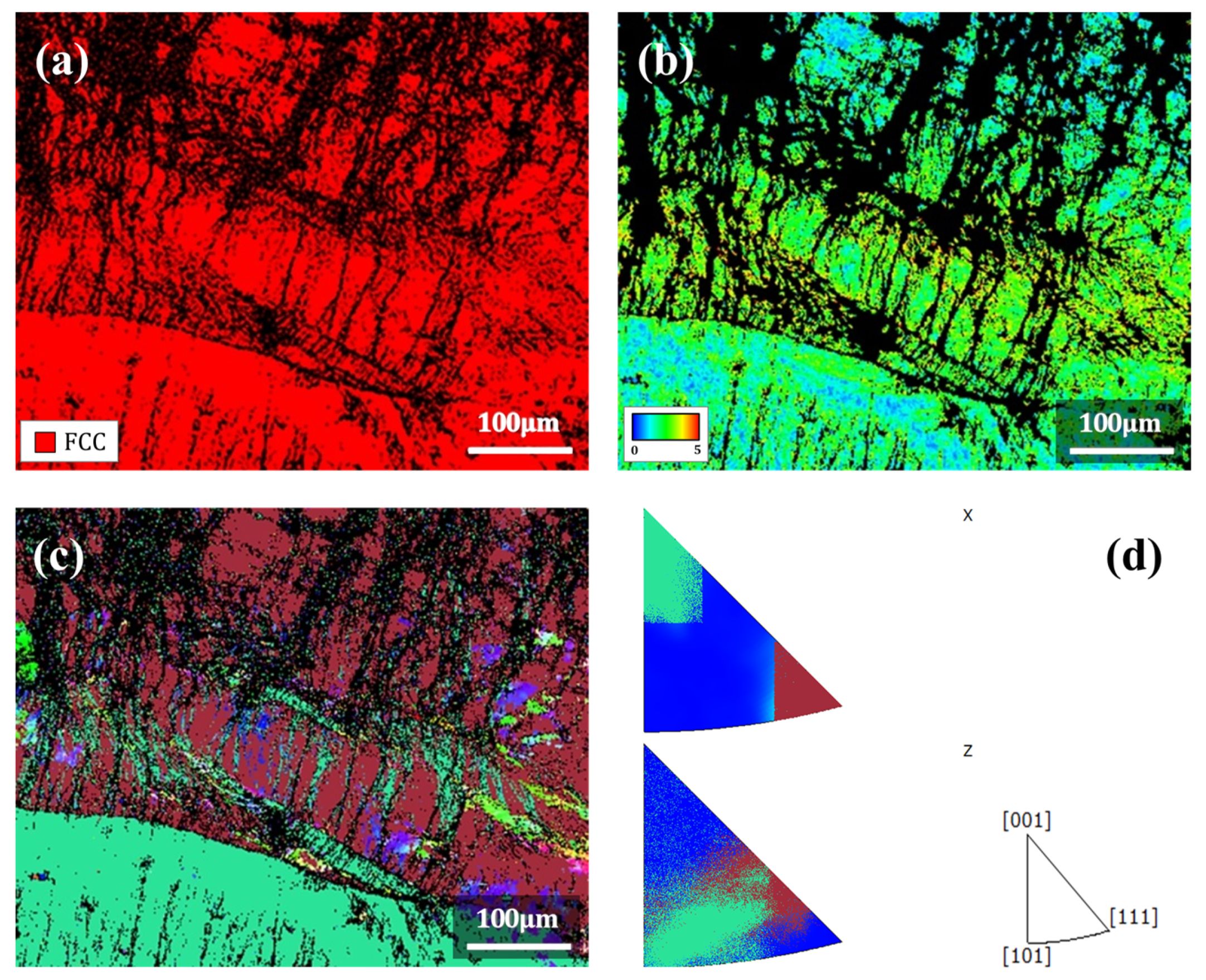
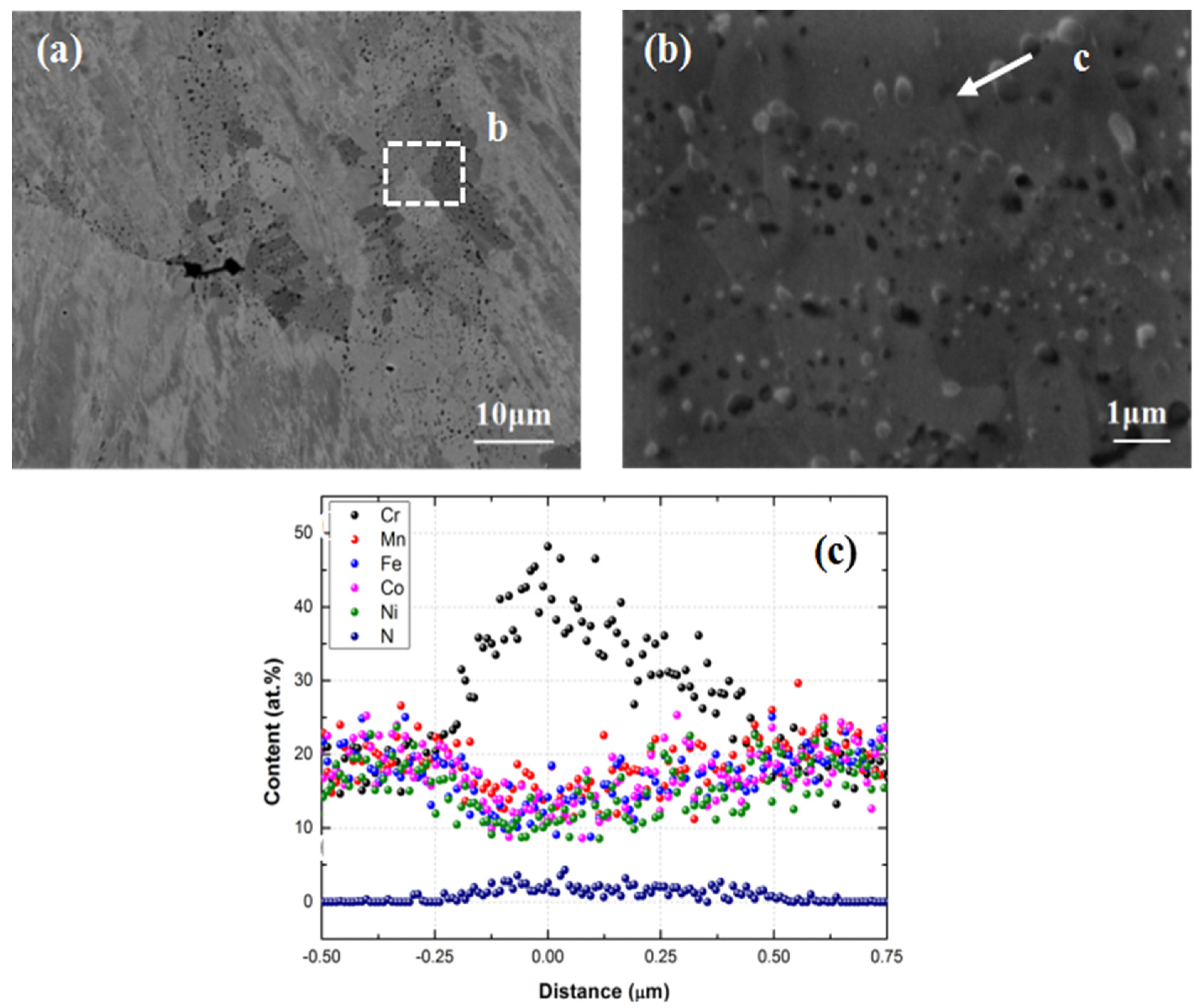
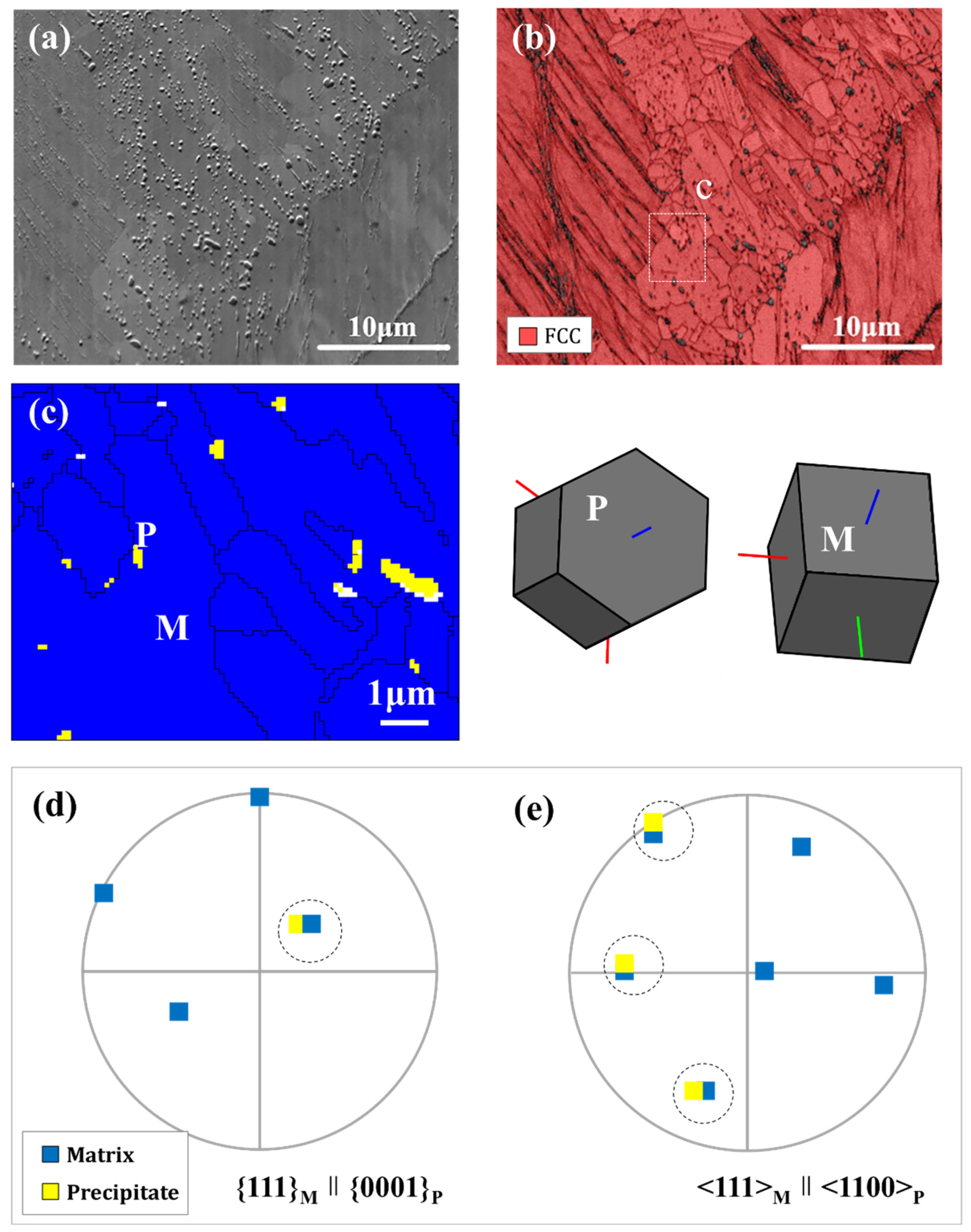
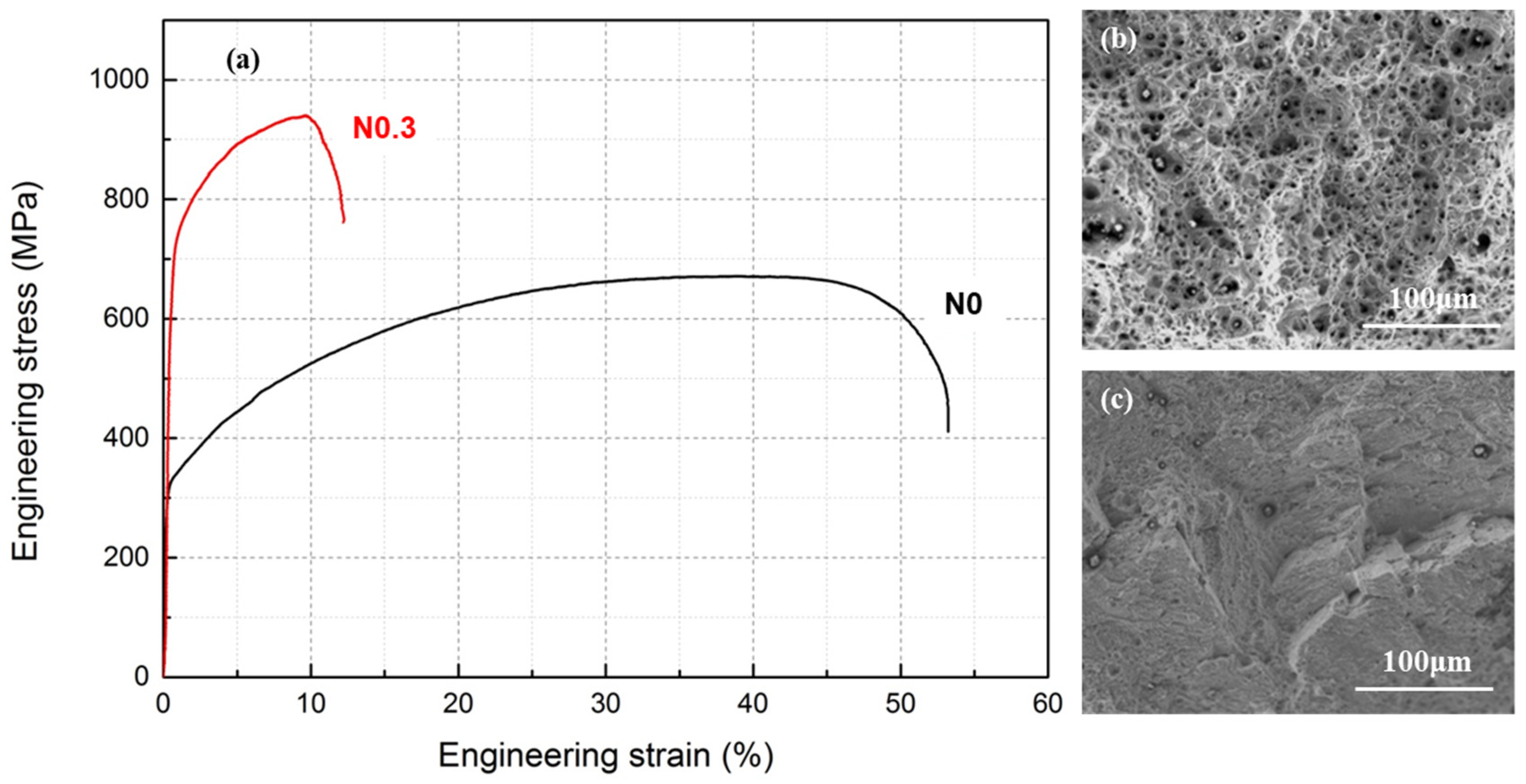
| Alloy | 2θ (°) | Lattice Constant (Å) |
|---|---|---|
| N0 | 43.36926 | 3.610846 |
| N0.3 | 43.26820 | 3.618874 |
Publisher’s Note: MDPI stays neutral with regard to jurisdictional claims in published maps and institutional affiliations. |
© 2021 by the authors. Licensee MDPI, Basel, Switzerland. This article is an open access article distributed under the terms and conditions of the Creative Commons Attribution (CC BY) license (https://creativecommons.org/licenses/by/4.0/).
Share and Cite
Zhang, J.; Yoon, K.N.; Kim, M.S.; Ahn, H.S.; Kim, J.Y.; Ryu, W.H.; Park, E.S. Manipulation of Microstructure and Mechanical Properties in N-Doped CoCrFeMnNi High-Entropy Alloys. Metals 2021, 11, 1487. https://doi.org/10.3390/met11091487
Zhang J, Yoon KN, Kim MS, Ahn HS, Kim JY, Ryu WH, Park ES. Manipulation of Microstructure and Mechanical Properties in N-Doped CoCrFeMnNi High-Entropy Alloys. Metals. 2021; 11(9):1487. https://doi.org/10.3390/met11091487
Chicago/Turabian StyleZhang, Jing, Kook Noh Yoon, Min Seok Kim, Heh Sang Ahn, Ji Young Kim, Wook Ha Ryu, and Eun Soo Park. 2021. "Manipulation of Microstructure and Mechanical Properties in N-Doped CoCrFeMnNi High-Entropy Alloys" Metals 11, no. 9: 1487. https://doi.org/10.3390/met11091487
APA StyleZhang, J., Yoon, K. N., Kim, M. S., Ahn, H. S., Kim, J. Y., Ryu, W. H., & Park, E. S. (2021). Manipulation of Microstructure and Mechanical Properties in N-Doped CoCrFeMnNi High-Entropy Alloys. Metals, 11(9), 1487. https://doi.org/10.3390/met11091487







